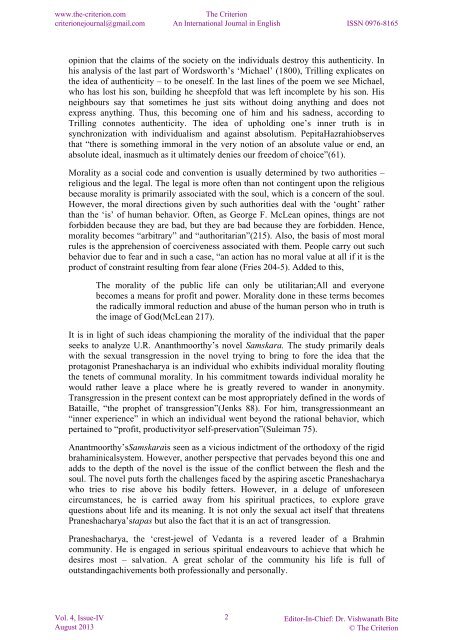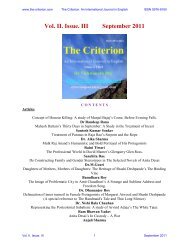PDF - The Criterion
PDF - The Criterion
PDF - The Criterion
You also want an ePaper? Increase the reach of your titles
YUMPU automatically turns print PDFs into web optimized ePapers that Google loves.
www.the-criterion.comcriterionejournal@gmail.com<strong>The</strong> <strong>Criterion</strong>An International Journal in English ISSN 0976-8165opinion that the claims of the society on the individuals destroy this authenticity. Inhis analysis of the last part of Wordsworth’s ‘Michael’ (1800), Trilling explicates onthe idea of authenticity – to be oneself. In the last lines of the poem we see Michael,who has lost his son, building he sheepfold that was left incomplete by his son. Hisneighbours say that sometimes he just sits without doing anything and does notexpress anything. Thus, this becoming one of him and his sadness, according toTrilling connotes authenticity. <strong>The</strong> idea of upholding one’s inner truth is insynchronization with individualism and against absolutism. PepitaHazrahiobservesthat “there is something immoral in the very notion of an absolute value or end, anabsolute ideal, inasmuch as it ultimately denies our freedom of choice”(61).Morality as a social code and convention is usually determined by two authorities –religious and the legal. <strong>The</strong> legal is more often than not contingent upon the religiousbecause morality is primarily associated with the soul, which is a concern of the soul.However, the moral directions given by such authorities deal with the ‘ought’ ratherthan the ‘is’ of human behavior. Often, as George F. McLean opines, things are notforbidden because they are bad, but they are bad because they are forbidden. Hence,morality becomes “arbitrary” and “authoritarian”(215). Also, the basis of most moralrules is the apprehension of coerciveness associated with them. People carry out suchbehavior due to fear and in such a case, “an action has no moral value at all if it is theproduct of constraint resulting from fear alone (Fries 204-5). Added to this,<strong>The</strong> morality of the public life can only be utilitarian;All and everyonebecomes a means for profit and power. Morality done in these terms becomesthe radically immoral reduction and abuse of the human person who in truth isthe image of God(McLean 217).It is in light of such ideas championing the morality of the individual that the paperseeks to analyze U.R. Ananthmoorthy’s novel Samskara. <strong>The</strong> study primarily dealswith the sexual transgression in the novel trying to bring to fore the idea that theprotagonist Praneshacharya is an individual who exhibits individual morality floutingthe tenets of communal morality. In his commitment towards individual morality hewould rather leave a place where he is greatly revered to wander in anonymity.Transgression in the present context can be most appropriately defined in the words ofBataille, “the prophet of transgression”(Jenks 88). For him, transgressionmeant an“inner experience” in which an individual went beyond the rational behavior, whichpertained to “profit, productivityor self-preservation”(Suleiman 75).Anantmoorthy’sSamskarais seen as a vicious indictment of the orthodoxy of the rigidbrahaminicalsystem. However, another perspective that pervades beyond this one andadds to the depth of the novel is the issue of the conflict between the flesh and thesoul. <strong>The</strong> novel puts forth the challenges faced by the aspiring ascetic Praneshacharyawho tries to rise above his bodily fetters. However, in a deluge of unforeseencircumstances, he is carried away from his spiritual practices, to explore gravequestions about life and its meaning. It is not only the sexual act itself that threatensPraneshacharya’stapas but also the fact that it is an act of transgression.Praneshacharya, the ‘crest-jewel of Vedanta is a revered leader of a Brahmincommunity. He is engaged in serious spiritual endeavours to achieve that which hedesires most – salvation. A great scholar of the community his life is full ofoutstandingachivements both professionally and personally.Vol. 4, Issue-IVAugust 20132 Editor-In-Chief: Dr. Vishwanath Bite© <strong>The</strong> <strong>Criterion</strong>
















